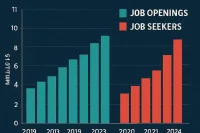Gold price breaks $4,000 for the first time in history, marking a monumental milestone in precious metals investing. The yellow metal has surged over 20% since the Federal Reserve’s dovish shift at Jackson Hole in August, completing this historic rally in just six weeks and establishing gold as the ultimate momentum trade of this century.
This unprecedented rally represents a perfect storm of economic factors, including Federal Reserve rate cuts, US government shutdown fears, and growing concerns about dollar diversification. The gold price breaks $4,000 barrier comes at a time when traditional safe-haven assets are experiencing renewed investor interest, while equity markets face increasing volatility and uncertainty.
What Makes This Gold Rally Different from Previous Surges
The current gold price breaks $4,000 rally distinguishes itself from previous precious metals surges through its remarkable speed and consistency. Unlike past gold rallies that were driven by specific crisis events, this surge represents a sustained momentum trade that has continued regardless of broader market conditions.
The rally has shown remarkable resilience, with gold continuing to gain even when both Bitcoin and the S&P 500 were in negative territory. This decoupling from traditional risk assets demonstrates gold’s unique position as a diversification tool and store of value in uncertain economic times.
The speed of the rally is particularly noteworthy, with gold gaining 20% in just six weeks since the Federal Reserve’s dovish pivot. This rapid appreciation reflects the intensity of investor demand for safe-haven assets and the magnitude of the economic concerns driving the precious metals market.
The Historical Context of Gold’s Performance
Gold’s journey to $4,000 represents a series of significant milestones that reflect major economic events throughout this century. The metal first crossed $1,000 during the Global Financial Crisis when the Federal Reserve implemented unprecedented monetary easing measures to combat the economic downturn.
The $2,000 threshold was reached during the COVID-19 pandemic, when governments worldwide began sending out stimulus checks and implementing massive fiscal support programs. This period marked a significant shift in monetary policy and government intervention in financial markets.
Gold reached $3,000 in April amid Trump tariff concerns and growing trade tensions, demonstrating the metal’s sensitivity to geopolitical and trade policy developments. The current gold price breaks $4,000 milestone represents the culmination of these various economic forces and investor concerns about currency debasement.
The Role of Federal Reserve Policy in Gold’s Rally
The Federal Reserve’s dovish shift at Jackson Hole in August served as the primary catalyst for the current gold rally. The central bank’s pivot toward more accommodative monetary policy created an environment where gold became increasingly attractive to investors seeking protection from potential currency devaluation.
The Fed’s rate cuts have reduced the opportunity cost of holding gold, which doesn’t pay interest or dividends. Lower interest rates make gold more attractive relative to other assets, particularly when combined with concerns about inflation and currency stability.
The lack of government data during the current period has made it difficult for investors to assess the true state of the economy, further driving demand for gold as a store of value. This uncertainty has created a perfect environment for precious metals to appreciate as investors seek safe-haven assets.
Riding the Momentum
The gold rally shows how momentum and psychology can shape markets, creating cycles of rising demand and price growth. Employers can take advantage of this shift by hiring finance and strategy professionals who understand market behavior and global diversification. Post your job on WhatJobs today and connect with candidates ready to help your business navigate market dynamics.
Post a Job Free for 30 Days →Gold’s Decoupling from Traditional Risk Assets
One of the most remarkable aspects of the current rally is gold’s ability to gain even when traditional risk assets are declining. This decoupling demonstrates gold’s unique characteristics as a diversification tool and its appeal to investors seeking assets that can perform independently of equity and cryptocurrency markets.
The fact that gold continued to gain 1% even when both Bitcoin and the S&P 500 were in negative territory highlights the metal’s role as a true safe-haven asset. This performance characteristic makes gold particularly valuable for portfolio diversification and risk management.
The decoupling also reflects changing investor attitudes toward gold, with many viewing it as a hedge against both inflation and deflation, as well as a store of value that can maintain purchasing power over time.
The Momentum Trade and Market Psychology
The current gold rally represents one of the most powerful momentum trades of this century, with the metal outperforming virtually every other asset class over the long term. This performance has created a self-reinforcing cycle where rising prices attract more investors, further driving demand and price appreciation.
The momentum trade has been particularly strong because of the lack of government data that could change the narrative. Without clear economic indicators to contradict the bullish case for gold, the momentum has been able to continue largely uninterrupted.
Ray Dalio’s comments about market frothiness and the need for diversification away from the US dollar have further supported the gold rally. His endorsement of gold as a diversification tool has resonated with institutional investors seeking to reduce their exposure to dollar-denominated assets.
The Future of Gold Investing
The gold price breaks $4,000 milestone represents a significant psychological barrier that could open the door to even higher prices. The metal’s strong performance and growing institutional acceptance suggest that this rally may have further to run.
The combination of Federal Reserve policy, economic uncertainty, and growing concerns about currency stability creates a favorable environment for continued gold appreciation. The metal’s ability to perform independently of other asset classes makes it an attractive addition to diversified portfolios.
The current rally also reflects broader trends toward alternative investments and diversification away from traditional financial assets. As investors become more concerned about the long-term stability of fiat currencies, gold’s appeal as a store of value continues to grow.
Frequently Asked Questions
What does gold price breaks $4,000 mean for investors and the economy?
Gold price breaks $4,000 represents a historic milestone that signals strong investor demand for safe-haven assets, reflecting concerns about Federal Reserve policy, economic uncertainty, and the need for portfolio diversification away from traditional risk assets.
How does the current gold price breaks $4,000 rally differ from previous precious metals surges?
Gold price breaks $4,000 rally differs from previous surges by its remarkable speed and consistency, gaining 20% in just six weeks while decoupling from traditional risk assets and continuing to gain even when equity and cryptocurrency markets are declining.
What factors are driving the gold price breaks $4,000 historic rally?
Gold price breaks $4,000 rally is driven by Federal Reserve rate cuts, US government shutdown fears, growing concerns about dollar diversification, and the metal’s unique characteristics as a safe-haven asset that can perform independently of other markets.
How can investors benefit from the gold price breaks $4,000 milestone?
Investors can benefit from gold price breaks $4,000 by adding gold to their portfolios for diversification, hedging against inflation and currency devaluation, and taking advantage of the metal’s momentum trade characteristics and long-term store of value properties.
A Real-World Example: David’s Gold Investment Journey
David Thompson, a 42-year-old financial advisor from Chicago, exemplifies how the gold price breaks $4,000 rally can transform an investor’s approach to portfolio diversification. After years of traditional investing focused on stocks and bonds, David was looking for alternative assets to hedge against economic uncertainty.
“I had been watching gold for years, but I was hesitant to add it to client portfolios because it seemed like a niche investment,” David explains. “When I saw the gold price breaks $4,000 milestone, I realized this wasn’t just a temporary spike but a fundamental shift in how investors view precious metals.”
David’s journey with gold investing began when he started adding gold ETFs and physical gold to his clients’ portfolios as a diversification tool. He was particularly attracted to gold’s ability to perform independently of equity markets and its role as a hedge against inflation and currency devaluation.
“The diversification benefits were immediately apparent,” David says. “When the S&P 500 was declining, gold continued to gain, providing much-needed stability to my clients’ portfolios. The gold price breaks $4,000 rally showed me that this wasn’t just a safe-haven play but a legitimate investment opportunity.”
Within six months of incorporating gold into his investment strategy, David had significantly improved his clients’ portfolio performance and risk-adjusted returns. He maintained strategic allocations to gold while using the metal’s momentum characteristics to enhance overall portfolio returns.
“Gold price breaks $4,000 taught me that alternative investments aren’t just for sophisticated investors,” David reflects. “The metal’s performance and growing institutional acceptance showed me that gold deserves a place in every diversified portfolio, especially during times of economic uncertainty.”




